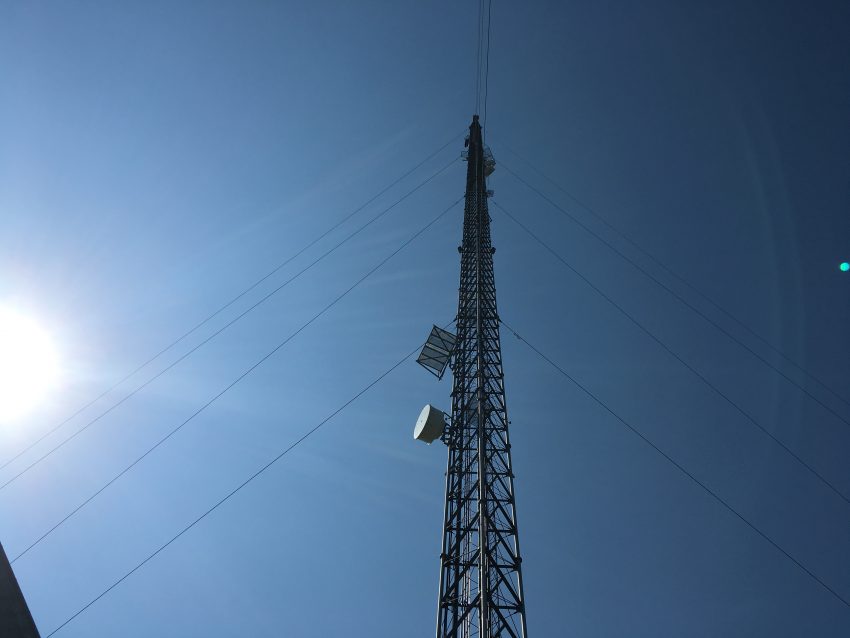This article was originally posted in July 2019.
This is the time of year when distant signals start to fill up the FM dial. Check the normally-empty spots between your local stations and you may hear signals coming from hundreds of miles away.
Most of these distant signals are brought in by troposphere-enhanced reception, but some are caused by E-skip. What’s the difference?
| Type | Distance | Duration | Cause |
| Tropo | Hundreds of miles | Many hours | Temperature inversion in the troposphere |
| E-skip | Thousands of miles | Minutes to hours | Ionization in the E layer |
| Meteor scatter | Thousands of miles | Milliseconds to seconds | Meteor trail |
On the FM and TV bands, the most common type of long-distance reception is tropospheric ducting, usually just called “tropo” by DX’ers (people who seek out distant signals). It happens when a temperature inversion in the troposphere (the lowest layer of the atmosphere) helps FM/TV signals travel farther than normal.
Hot, muggy summertime weather usually means great tropo reception. Distant stations may fade in and out but generally will come in for hours or even days.
Troposphere-enhanced reception is more noticeable in rural areas with few strong local signals. The enhanced reception will strengthen stations that usually come in weakly and also bring in stations from farther away that can’t usually be heard.
Tropo is most intense during the summer but can actually happen at any time of year. It can affect FM and TV, both VHF and UHF.
The more exciting, and rarer, type of long-distance FM/TV reception is E-skip. This type of reception is less predictable because it’s not directly tied to the weather; instead, it’s caused by ionization of the E layer of the atmosphere, which sometimes happens in the summer during the midday, afternoon, and sometimes evening.
During an E-skip event, listeners will hear FM stations from another part of the continent fading in and out very quickly. At their peak, the signals can be so strong that they sound like a local station and will even stop on “scan” on your car radio – but then disappear within seconds.
During a stronger event, the same station may fade in and out for hours. Often, multiple stations will mix on the same frequency. Here is an example recorded in Cedar Rapids in 2005, when a Las Vegas station was mixing with an unidentified station (with additional splatter from an adjacent regional station):
Note how it sounds as if someone is moving an antenna back and forth, or as if you’re driving down the highway and the stations are competing. In fact, this was recorded with a stationary radio and antenna – it was actually variations in the E layer ionization that were causing the stations to switch back and forth.
Listening to the atmosphere – kind of cool, right?
No special type of receiver or antenna is required to hear distant stations, though a better radio and bigger antenna will always help. Car radios (while stationary) are usually your best bet.
Tune to a frequency that doesn’t have a local station and see if you hear something unusual. (You can use a site like Radio-Locator to find out what stations are considered normal for your area.)
Besides FM, E-skip can also affect the VHF Low TV band (channels 2-6). However, the transition to digital broadcasting limited this phenomenon greatly, partly because digital TV signals are harder to decode when they’re rapidly fading in and out.
But more importantly, there are now far fewer stations transmitting on channels 2-6 in the United States because almost all VHF Low TV stations moved to VHF High or UHF during the digital transition (but continue to identify as channel 2-6 through PSIP renumbering).
There are still analog stations on VHF Low in Mexico, Cuba, and rural parts of Canada. DX’ers are still receiving these stations via E-skip, along with the few digital VHF Low stations that are on the air in the U.S.
Meteor scatter is somewhat similar to e-skip in the distance of reception, but is much shorter in duration – often it’s literally only a few milliseconds. Some DX’ers using software-defined radios are able to identify these stations using RBDS data.
(A similar phenomenon can sometimes be heard when a plane is flying overhead, but instead of stations from thousands of miles away, you’d only be getting enhanced regional reception due to the sharper angle of the signal path.)
It’s important to understand that the AM and FM radio bands work very differently because of their different wavelengths. Check this article for information on distant AM reception.
For more information on FM and TV DX’ing, check the World TV/FM DX Association and the Wikipedia article on TV and FM DX.

